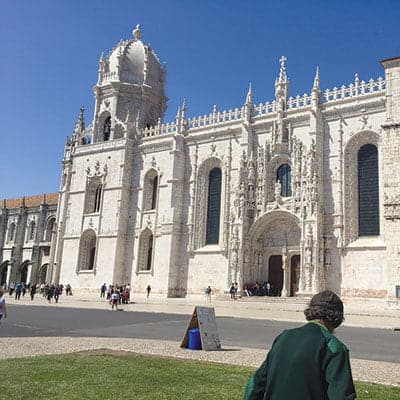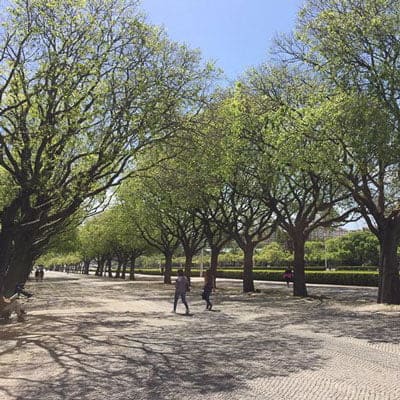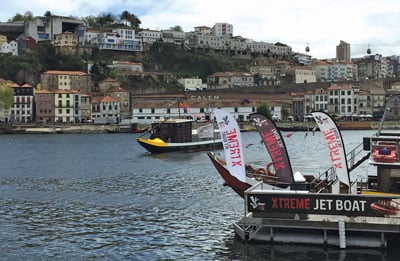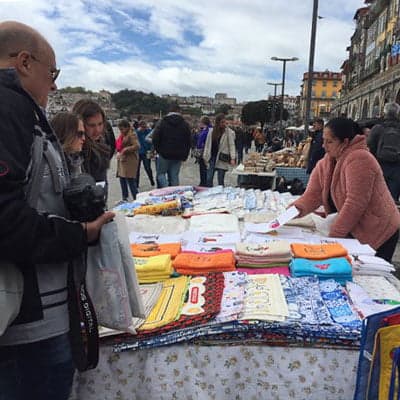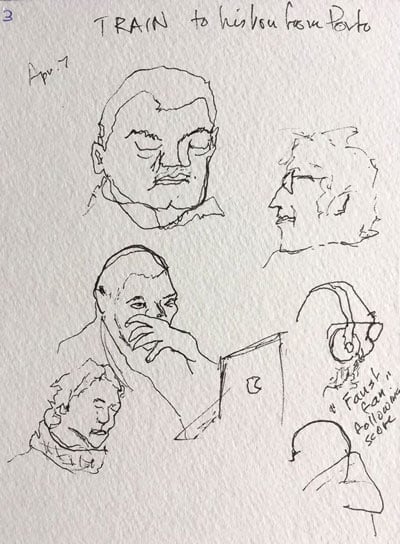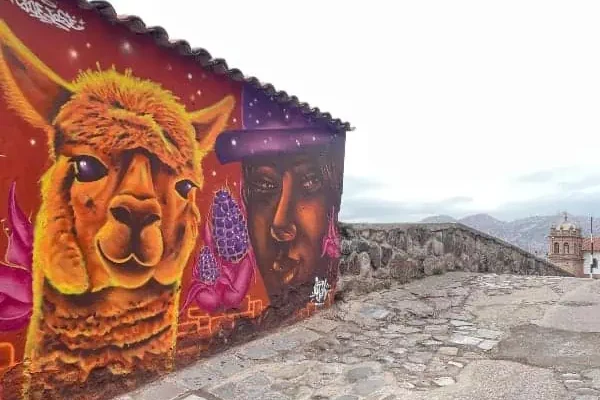Here are some of my tips on travel to Portugal as a curious 70-year-old with a “willing to try it at least once” philosophy. This is based on two weeks travelling by train with another 69-year-old woman in late March and April. We landed in Lisbon, headed south to Faro (yes, there is a Faro in Portugal), further east to Tavira, back to Lisbon, a day trip to Evora in Central Portugal, north to Porto and back to Lisbon for home.
[two_third]
Research and focus your interest
- Focus. When travelling with a friend, be clear about what you both want to get out of the trip. Is it to see the cathedrals, architecture and artwork? To experience the port wine, traditional food and music? See megalithic and historical sites or “tourist stops?” Shop ‘til you drop at local markets or shopping centres? Go on a bird-watching river tour in a solar-powered boat? Enjoy quiet contemplation or creative time? You can, as we did, find all of these and more in Portugal.
- Remember how much time you have and what is on your “must do or see or be” list. Do your research before you go. Consult guidebooks, friends and, with a certain degree of skepticism, Trip Advisor and Booking.com. We booked one 10-hour tour to Evora with our own guide. It was expensive, but well worth it. The only other guided tour we took was to the Porto wine tasting and winery. Walking poles were especially useful for the winding and hilly cobblestone streets.
- I bought a SIM card for my cellphone in the Vodafone store in the Portugal airport. (Keep your Canadian one in a safe place!) The plan was more economical than adding to my existing plan. It was great for Google Maps, contacting family members, emailing, texting and making local calls.
- Be bold and go to the Tourist Info Centre! In all innocence, the first time I made a list of three or four questions to ask. Playing the dumb tourist card, I told the clerk about the list and was met with a stony silence. This was common in all the info centres, except Porto and Evora. I wondered if it was a cultural thing, or we had caught them all on their bad day, or they were tired of the same “dumb” questions? It became a standing joke and we made it our mission to leave a little smile on the faces of the clerks who provided services in info centres and train stations. We did manage a couple of times! On the other hand, people on the street were often very helpful even if they had no English and we had our limited Portuguese pocket guides.
- Lisbon is a city, what more can I say? There are people, traffic and noise BUT we chose what we wanted to see. We bought a day pass for use on various forms of public transit. The system was relatively easy to navigate once we understood the various lines. We headed to Mosteiro dos Jeronimos in the Belem district. The monastery was built in the early 1500s and we were amazed by the architectural styles and artwork.
- On our final day in Lisbon, my friend chose to go to the Museu Calouste Gulbenkian, which has an amazing collection of Egyptian, Islamic, Asian and European art. I opted to explore the Parque Eduardo VII and Jardim Amália Rodriques, lovely parks that were across the street from our guesthouse! I enjoyed a café au lait and another custard tart! I also had time to smell the roses, and do some Tai chi and a bit of writing in a quiet area.
Uncovering the “accommodations” code
- There is a wide range of choices when it comes to accommodations. We found you can’t just rely on the price, or the label of hostel, guesthouse or hotel! We stayed in all three types. Across Lisbon, Porto, Faro and Tavera, they varied in price from 45 Euros to 100 Euros per night for two adults.
- The worst place we stayed was the most expensive. The hostel in Lisbon city centre was located above a train station. We renamed it “Desperation Hostel.” It had a shared, dirty bathroom, a hot and stuffy bedroom and an extra charge for a towel. We stayed in two other Lisbon guesthouses with kitchen access and proximity to public transit, train stations and the airport. At 45 to 50 Euros, they were half the price of the hostel and of good to excellent quality. All places were quiet after 10 p.m., including the hostels.
- Consider the most convenient location for proximity to sights you want to see. Check access to transportation systems you’re using, keeping in mind that train stations are not necessarily close to bus systems.
Quirky systems or was it the quirky tourist?
- The locking system on doors! To be honest, I still haven’t figured it out. In our guesthouses we had individual keys for our room, the apartment door and the outside door. They had skeleton-style keys with a double locking mechanism that required a specific sequence of turns. Most times we fiddled around for a few minutes before the proprietor opened the door, smiling patiently at us!
- Other differences included when to “push/pull” a door, or when to pay at a café or coffee shop. I had one café clerk shout after me when I unintentionally started to walk out without paying. We’d been there so long enjoying our café au lait and custard tart, we simply forgot. The bonus is that you never feel rushed to finish your meal, no matter where you go.
- Lisbon has several districts and it is sometimes difficult to figure out where you are in relation to the place you want to go. In one case, the Uber driver had difficulty and had to phone the guesthouse. We found that taxis were sometimes difficult to find. Toward the end, we used Uber electric cars in Porto and Lisbon, which worked really well since they rely on Google Maps to find your precise location.
I could go on at length about the cultural insights and miscommunication, but I leave that for you to discover if you go to Portugal! You can be assured of an exciting adventure and, on the whole, a very welcoming place!
[/two_third]
[one_third_last]
[/one_third_last]

